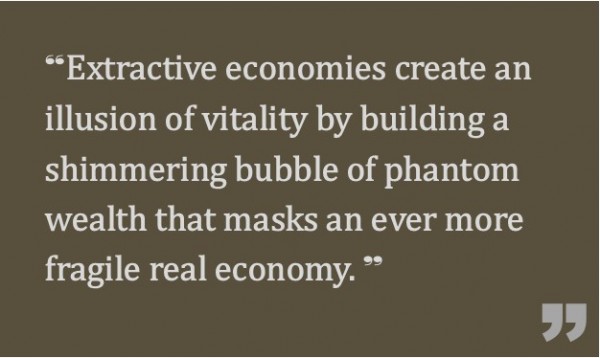PERSPECTIVE l The Problem of Rising Rents and Falling Incomes Seen Through the Regenerative Lens
/by Sally Goerner “We are the poorest urban county not because we can’t produce wealth, but because we haven’t built what we need to capture it. You spend your life enriching someone else, somewhere else.” –Yorman Nunez, The Bronx Cooperative Development Initiative, 2013
Affordable housing is very much in the news these days, especially in urban areas like New York and San Francisco where unaffordability is reaching crisis proportions. Minimum wage is clearly not keeping up with rising housing costs in these areas, but at some level most people intuit that endlessly increasing the minimum wage is a losing battle that won’t allow workers to keep up with skyrocketing rents. The unstated obstacle to finding a better way is that we lack a compelling explanation for why a growing gap between rents and income is a problem not just an inevitability.
 To be sure, Keynesians point out that city health in general is harmed when local monetary circulation goes down because a larger slice of income going to rent means more money flowing upward and less circulating horizontally. But, the neoclassical and neoliberal economists who dominate policy discussions tend to see this issue as simply a matter of the detritus of unerring market forces. Regenerative economics creates a very different way of looking at this conundrum – one which suggests more lasting solutions.
To be sure, Keynesians point out that city health in general is harmed when local monetary circulation goes down because a larger slice of income going to rent means more money flowing upward and less circulating horizontally. But, the neoclassical and neoliberal economists who dominate policy discussions tend to see this issue as simply a matter of the detritus of unerring market forces. Regenerative economics creates a very different way of looking at this conundrum – one which suggests more lasting solutions.
Regenerative economics places the problem of rising rents and falling incomes squarely within today’s context of massive and unrelenting concentrations of wealth at the very top; erosion of the middle class; and money flowing into speculative investments, not the real economy. Since robust cross-scale circulation is a critical factor in systemic health, the regenerative lens sees all of these events as signs of growing economic necrosis – the slow starvation of economic tissue due to too much money flowing to the top, and too little circulating throughout the rest of the real economy.
Economic necrosis sets in when: 1) rents go up because a few people have lots of money, and higher rents extract more from lower levels; while, 2) jobs and wages are going down because the small and medium-sized, real-economy organizations that produce most jobs are experiencing monetary starvation. Increasing the minimum wage helps somewhat, but it is a temporary, Band-Aid solution to the deeper problem of a frail real-economy with feeble job-creation due at least in part to too much money flowing away from the local real-economy organizations instead of circulating throughout middle and lower scales within. In other words, there are systemic limits to the extraction of wealth by “rentiers,” not just ethical considerations.
Instead of viewing today’s situation as the inevitable outcome of free-market forces, regenerative thinking follows Daron Acemoglu and James A. Robinson’s work in Why Nations Fail (2012), seeing all of these events as indications of an extractive economy, one designed politically to support the process of wealth moving upwards. Using concrete examples such as Nogales, Mexico, and Nogales, Texas, which are culturally and geographically identical, but politically and economically distinct, Acemoglu and Robinson demonstrate that the underlying problem of poverty lies in how much the political system supports economic policies designed to move wealth upward (extractive) versus those designed to empower, develop, and circulate. These latter characteristics are all features of a Regenerative economy.
supports economic policies designed to move wealth upward (extractive) versus those designed to empower, develop, and circulate. These latter characteristics are all features of a Regenerative economy.
Extractive economies create an illusion of vitality by building a shimmering bubble of phantom wealth that masks an ever more fragile real economy. In contrast, Regenerative economies seek to build long-term, cross-scale, economic vitality precisely by re-invigorating the small and medium-sized, real-economy organizations that are currently so malnourished. Taken together, the key principles of Regenerative economics show how to develop exactly those structures and processes that allow local communities to both produce wealth and circulate it back into the self-feeding economic arrangements that maintain vitality for long periods of time. This is what Regenerative means.
As it turns out, the real-economy revitalization process we need is already underway as witnessed by New Economy efforts ranging from the organic farm movement to the Evergreen Cooperatives of Cleveland. As the Bronx Cooperative Development Initiative (BCDI) shows, interest in building regenerative systems is already apparent:
BCDI is guided by a deep intention to harness the essence of the people, resources, and place of the Bronx, and to enable the members of the community to co-create the borough’s regeneration… BCDI has been undertaking considerable work in laying the ground for this more holistic approach, building out a collaborative of organizations focusing on a regional development strategy to support economic democracy in the borough, with shared ownership at the core of that vision. The collaborative includes local business leaders, organized labor, anchor institutions, including hospitals and universities, and the local zoo, as well as a diverse array of local nonprofits.
Regenerative financing is also beginning to emerge. Our Field Guide to Investing in a Regenerative Economy, for example, tells the story of Bendigo Community Banks (BCB). Begun in the 1990s, BCB reflects a “self-organizing” response to the closing of over 2,000 bank branches in rural Australia. Suddenly cut off from access to financial capital, residents and businesses of these communities appealed to Bendigo Bank to reestablish a banking presence in these areas. Now 300 strong, the resulting bank model – part franchise and part cooperative – has helped revive these communities, and given local leaders the business acumen and tools they need to sustain their own regenerative process.
A hemisphere away, in Sierra Gorda, Mexico, the not-for-profit Grupo Ecologico is developing innovative funding mechanisms for empowering a network of resourceful, but impoverished, small farmers and ranchers seeking to become regenerators of their own land and communities in one of the most biodiverse regions of the world.
Still, to truly revitalize the entire economy, these important efforts will require upper-level support in the form of improved financial flows, policy reforms, political reforms, and more apropos economic theory and measures. In contrast to “top-down” approaches such as conventional monetary and fiscal policy, or “bottom-up” approaches such as the local economy movement or even Occupy Wall Street, Regenerative economics sees connecting high-level reforms in a way that reinforces grassroots efforts as critical because regenerative health is a systemic affair which requires cross scale integration. We believe the Regenerative lens can clarify how to make such integrated reforms produce the sustainable vitality we all desire.
Dr. Sally Goerner is Science Advisor for Greenwich-based Capital Institute. The organization’s mission is to explore and effect the economic transition to a more just, regenerative, and thus sustainable way of living on this earth through the transformation of finance.
_________________________________________________________
CT by the Numbers publishes opinion articles of 600 words or less. Submissions should be emailed to info@ctbythenumbers.info. Perspectives are published at the discretion of CT by the Numbers.





























